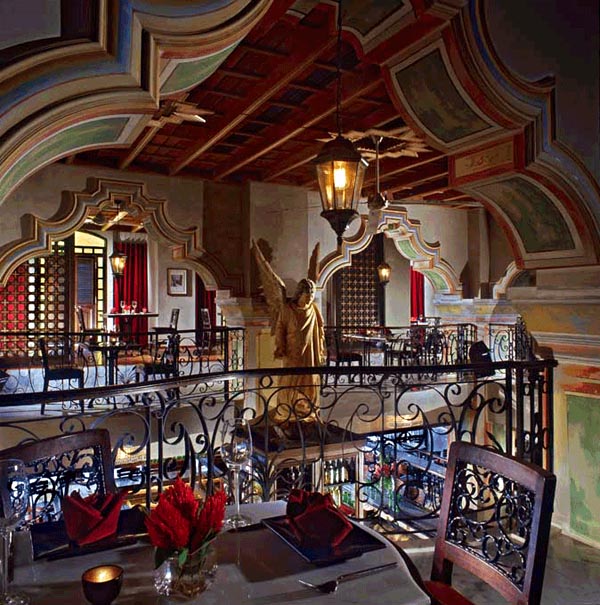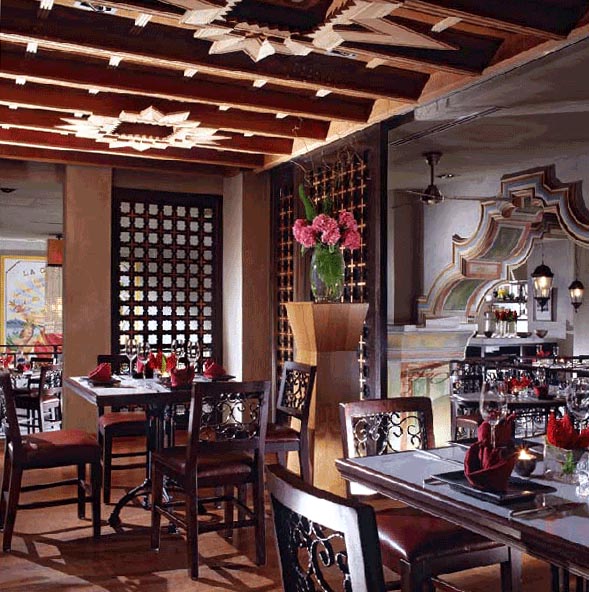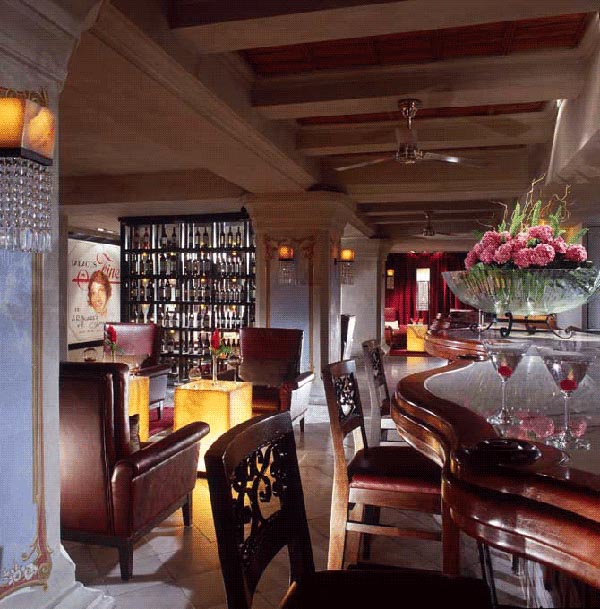|
Five main areas compose QBA : downstairs,
there is an alfresco tapas garden for light, economical meals, and an
island bar flanked by booth seats and a stage for live Cuban bands.
Upstairs, there is a private cigar divan and a wine bar, as well as the
main paladar dining room, which overlooks the downstairs bar. Aside
from the grand staircase [complete with typically Cuban balustrade post
statuette], which leads to the upstairs dining room, the focal point of
QBA is inarguably the resident angel - carved from a single tree trunk and
painstakingly painted and sanded back numerous times to create an "instant"
aged patina - represents a motif commonly found in and on Catholic
churches in Cuba.
The imposing seriousness of the angel is
countered somewhat by the simple furniture selected by Poole; the timber
chairs and barstools are of an elegant, yet unpretentious design, which
achieves a satisfying balance between old-fashioned and contemporary
styles. Heavy Spanish-baroque style scrolls hem the downstairs booth
seats, whose leather upholstery is reminiscent of the interiors of the
classic cars that swing around Cuba's streets. The decorative floor tiles
that line the island bar area were custom-made in Malaysia. The pattern is
based on one observed by Poole in a Cuban church. Elsewhere are white
marble floor tiles - a common Cuban building commodity. |
|
A paladar is a Cuban house
that has been converted into a restaurant, usually seating no more than 12
persons. These establishments are encouraged by the Cuban Government due to
a shortage of restaurants and growing tourism in the country. |
Behind the guardian angel sweep the curving
archways that confine the upstairs dining room. The scale of the arch spans
were designed with the large door openings of Cuban houses in mind. The
baroque-style trim moldings on the arches were all custom-made; the process
involved hollow-setting concrete reinforced with fiberglass and steel in a
fiberglass mould. The set form was then attached and sealed to the main
arch. The distressed paintwork on the trims were applied by hand by
Californian artist, muralist and renderer Willy Baet, as were the scroll
motifs on the walls. This goes some way to explaining the rather lengthy
nine-month-long construction period. Cuban cigar bands were the inspiration
for the design of these wall motifs. Baet is also responsible for the
specially produced artwork that hangs within QBA. For these pieces he took
his inspiration from Cuban cigar labels.
|
|
Project Design Team :
Poole
Associates Private Limited
Ed Poole, Mateo H. Osorio Jr.,
Wong
Kim Mei, Norman
Anton
e:mail
contact@poole-associates.com
T
65 | 6536 | 3928
Photos :
Peter Mealin Photography
[above]
Below : courtesy of Westin
KL |
An open kitchen greets patrons
at the top of the staircase. A corridor leads away to the wine bar and cigar
smoking area. The wine bar's scroll bar top, curling in and out to form
niches, allows patrons to sit almost facing each other along the bar.
Crystal chandeliers, lamps and wall lights, which are abundant around the
curly bar, were also designed by Poole. His selection of old-fashioned
German filament globes was a deliberate play on the "old world charm" theme.
The light thrown out from behind panes of onyx on the fittings is warm,
yellow and comforting. The ceiling fans that hang above the bar were also
custom-designed by Poole. They bear an enormous blade span diameter of 3.5
meters, from which the deliberate colonial connotations can not escape.
Although utterly successful,
such a decorative interior does come as something of a surprise to those of
us accustomed to the slick brand of minimalist design that so many
contemporary establishments strive to achieve. For many, the modernist
dissent for ornamentation remains a mark of advancement and superiority.
Yet, such a viewpoint ignores the primary intention of ornament - to give
pleasure. Theatrical, emotionally charged, dramatic, passionate and
engaging, the decorative interior of QBA is delicious in its indulgence and
excess, offering much visual pleasure whilst remaining absolutely reflective
of the rough brilliance of Cuba. |








